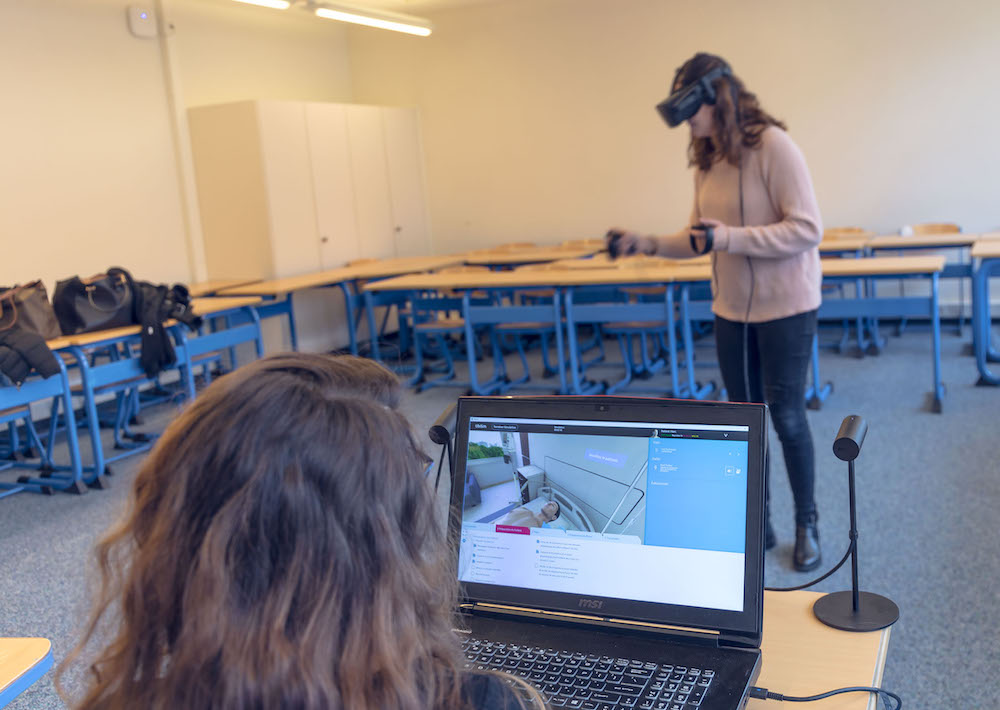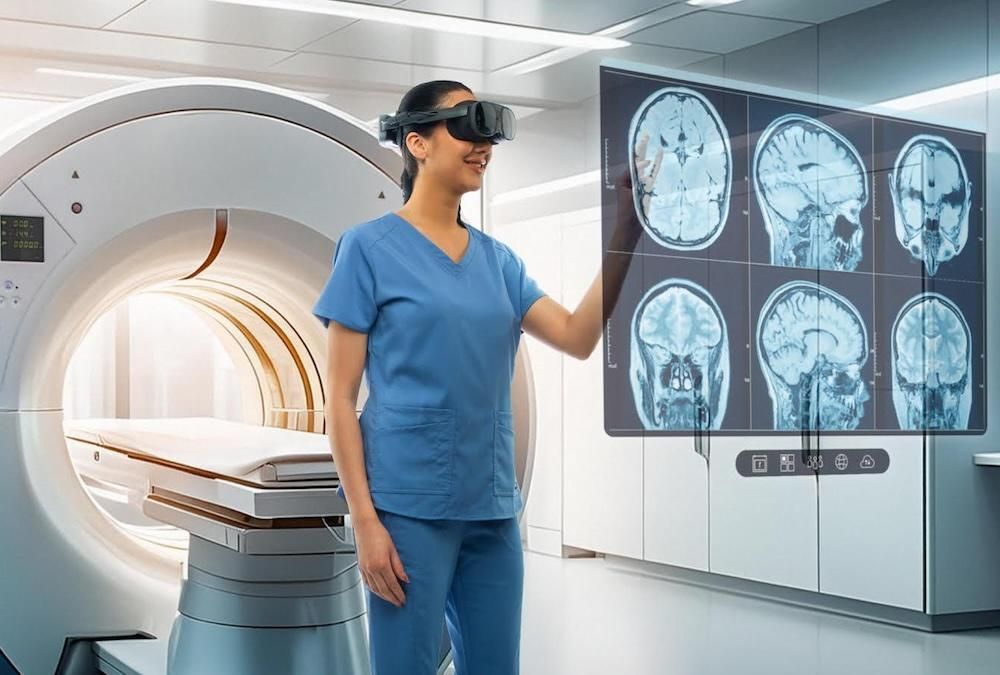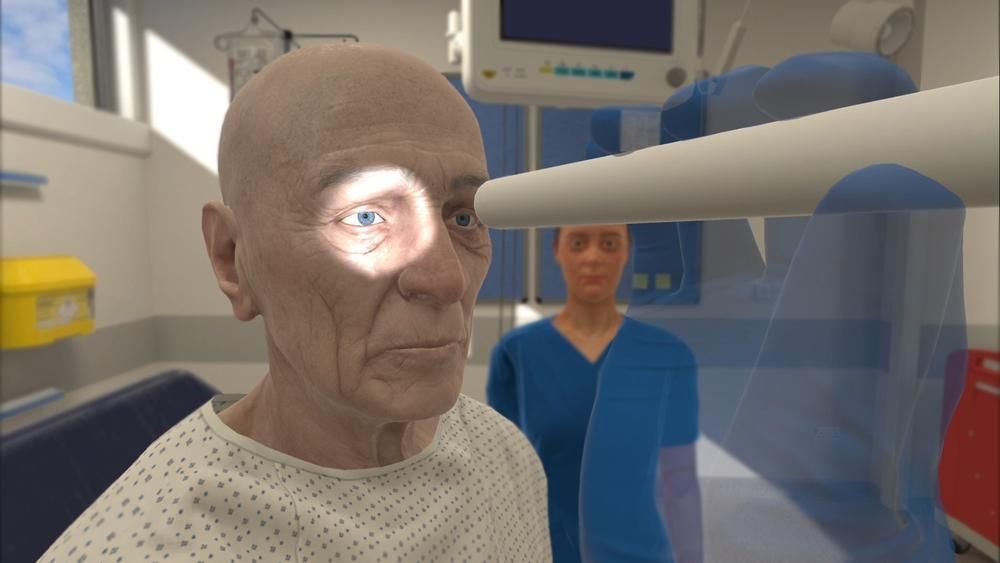Immersive virtual reality (VR) simulation empowers nursing educators to provide quality learning experiences to students that are unable to attend clinical sites during the COVID-19 pandemic. Immersive VR provides a high-fidelity simulation experience in which learners don headsets and become fully immersed in the virtual world. There are many benefits to VR simulation, including the ability to provide a robust and interactive learning experience while adhering to social distancing guidelines. This equips educators with a solution for preparing students to provide high quality care in their communities upon graduation.
Today’s article, submitted by Maria D’Errico, DNP, APRN, FNP-BC, CHSE, will discuss how educators can structure a clinical learning experience using immersive VR simulation. The recommendations in this article are based on the INACSL Standards of Best Practice: Simulation, which guide educators in providing a meaningful learning experience. The discussion in this article is intended as an example, and educators should check with their specific state nursing boards and accreditation bodies when determining the clinical hours that can be substituted with virtual simulations. Those interested to learn more could subscribe to watch Maria’s upcoming HealthySimulation.com webinar on September 15th entitled Beyond the Simulation Lab: Designing Immersive Virtual Reality Simulations!
Pre-Simulation Activities
Educators must prepare students for the simulation-based experience, accomplished by assigning students pre-simulation activities that align with their learning level and the simulation learning objectives. The length of time it takes students to complete these activities may vary, but 1 to 2 hours is a reasonable estimate to ensure adequate preparation. Activities include readings from course textbooks, educational videos, or case studies. Students can review the virtual patient’s chart, research the patient’s diagnoses, medications, and treatments, and complete a pre-clinical worksheet that supports knowledge synthesis. Pre-simulation activities can be completed by students asynchronously at home or at a scheduled time on campus before participating in the simulation scenario.
It is best practice to hold a structured prebriefing before the simulation scenario. A written or recorded prebriefing can ensure consistency and standardization while also making it scalable to many learners. During this time, educators set the tone and establish psychological safety by clarifying expectations, placing the emphasis on learning, and assuring students that they will not be punished for making mistakes. This is also a time to establish ground rules and review the simulation learning objectives.
Prebriefings should include an orientation to the virtual room and the equipment that will be used during the simulation. For our immersive VR scenarios at UbiSim, we have a standardized orientation scenario that provides students with an opportunity to don the VR headset, explore the simulated hospital room, and operate the virtual equipment prior to starting the scenario. When using the UbiSim platform we recommend an open area measuring at least 6.5 feet x 6.5 feet for the student that is engaged in the VR scenario. Student observers can be spaced apart within the classroom to ensure social distancing.
Prior to ending the prebrief, educators should clearly explain the roles students will have during the simulation. For a UbiSim experience, the student may be participating in the immersive scenario as the nurse, choosing the patient dialog from the computer as the operator, or watching their peer participate in the clinical scenario as an actively engaged observer. Educators can provide time in the prebriefing for students to prepare for the simulation, via an interactive question and answer session between the educator and students, a peer huddle to plan care of the virtual patient, or a quiet time for students to reflect and gather their thoughts prior to starting the scenario.
Although pre-briefing times may vary depending on the scenario complexity and level of the learner, 1 hour is a reasonable designated time for a prelicensure nursing student.
Implementing the Simulation Scenario
Educators have the flexibility to implement immersive VR simulation in a variety of ways. Two ways that educators often use UbiSim is in a peer-to-peer learning model and faculty-led in a classroom setting.
Peer-to-Peer Model
Peer-to-peer learning teaches students teamwork, communication, and collaboration skills. Educators have the flexibility to choose the size of the peer group that best fits their situation. When using UbiSim, many educators choose to run the peer-to-peer model in groups of two or three students. Using a group of three peers as an example, the students will rotate between participating in the VR scenario, operating the standardized patient dialog on the computer, and taking notes during the simulation as an actively engaged observer. Each student has a defined role during the simulation experience and remains an active participant even when they are not immersed inside the VR scenario.
Using a 20-minute UbiSim scenario as an example, it would take 1 hour for each of the three students to participate in the simulation.
Faculty-Led in a Classroom
While one student is immersed in the VR scenario, a faculty facilitator populates customized patient dialog from the computer. A group of actively engaged student observers watch the simulation and take structured notes on what occurs during the scenario. Educators can pause the scenario at key moments so both the participant and observers can reflect in action and collaborate on the nursing care of the virtual patient.
Using a 20-minute UbiSim scenario, it could take faculty an estimated 20 to 30 minutes to complete the simulation depending on the number of pauses. Next, we discuss the debriefing process.
Debriefing
To align with best practice, a structured debriefing should follow each simulation-based experience. A general guide is for the debriefing to last twice the time of the simulation scenario. The UbiSim platform has a built-in debriefing experience that includes a recording of the simulation, evidence-based feedback that populates in response to the students’ actions during the scenario, and guided reflection questions based on the PEARLS debriefing framework. This provides students with an opportunity to reflect on their performance and ways to improve their nursing care.
Debriefing can be done in several different ways, depending on how the educator chooses to implement the scenario with students. If the scenario is faculty-led in a classroom, a 40 minute debrief would follow the 20 minute simulation scenario. In the peer-to-peer model, students can debrief between each run of the scenario before the next student participates in the simulation. After the third student completes the scenario, the final debriefing can focus on reflecting beyond action as they identify key takeaways from the simulation experience that they can apply to their nursing practice. In this model, a debrief would occur three times, which would collectively account for 120 minutes of debriefing time.
Post-Simulation Learning Activities
After the debriefing, educators can assign post-simulation activities that help students to synthesize their learning. Examples include documentation exercises, concept maps, or completing a nursing care plan for the virtual patient. These activities can be planned to mirror the activities students complete after their in-person clinicals.
Conclusion
Immersive VR provides a viable, effective setting for structured clinical learning experiences. Specific to the COVID-19 pandemic, immersive VR equipment is ideal for a socially distanced learning experience, as not much physical space is needed and the sanitization process is generally simpler when compared to manikin-based simulations. The UbiSim VR platform provides a simulation experience that allows nursing students to progress through their education programs, even in the reality of limited clinical placements due to the pandemic. Judicious utilization of simulation modalities such as VR can ensure that our nursing workforce is replenished with the next generation of nursing professionals.









